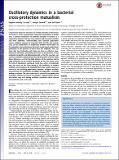Oscillatory dynamics in a bacterial cross-protection mutualism
Author(s)
Yurtsev, Eugene; Conwill, Arolyn Macdonald; Gore, Jeff
DownloadOscillatory dynamics in a bacterial.pdf (6.373Mb)
PUBLISHER_POLICY
Publisher Policy
Article is made available in accordance with the publisher's policy and may be subject to US copyright law. Please refer to the publisher's site for terms of use.
Terms of use
Metadata
Show full item recordAbstract
Cooperation between microbes can enable microbial communities to survive in harsh environments. Enzymatic deactivation of antibiotics, a common mechanism of antibiotic resistance in bacteria, is a cooperative behavior that can allow resistant cells to protect sensitive cells from antibiotics. Understanding how bacterial populations survive antibiotic exposure is important both clinically and ecologically, yet the implications of cooperative antibiotic deactivation on the population and evolutionary dynamics remain poorly understood, particularly in the presence of more than one antibiotic. Here, we show that two Escherichia coli strains can form an effective crossprotection mutualism, protecting each other in the presence of two antibiotics (ampicillin and chloramphenicol) so that the coculture can survive in antibiotic concentrations that inhibit growth of either strain alone. Moreover, we find that daily dilutions of the coculture lead to large oscillations in the relative abundance of the two strains, with
the ratio of abundances varying by nearly four orders of magnitude over the course of the 3-day period of the oscillation. At modest antibiotic concentrations, the mutualistic behavior enables long-term survival of the oscillating populations; however, at higher antibiotic concentrations, the oscillations destabilize the population, eventually leading to collapse. The two strains form a successful cross-protection mutualism without a period of coevolution, suggesting that similar mutualisms may arise during antibiotic treatment and in natural environments such as the soil.
Date issued
2016-05Department
Massachusetts Institute of Technology. Department of PhysicsJournal
Proceedings of the National Academy of Sciences
Publisher
National Academy of Sciences (U.S.)
Citation
Yurtsev, Eugene Anatoly, Arolyn Conwill, and Jeff Gore. “Oscillatory Dynamics in a Bacterial Cross-Protection Mutualism.” Proceedings of the National Academy of Sciences 113.22 (2016): 6236–6241. © 2016 National Academy of Sciences
Version: Final published version
ISSN
0027-8424
1091-6490